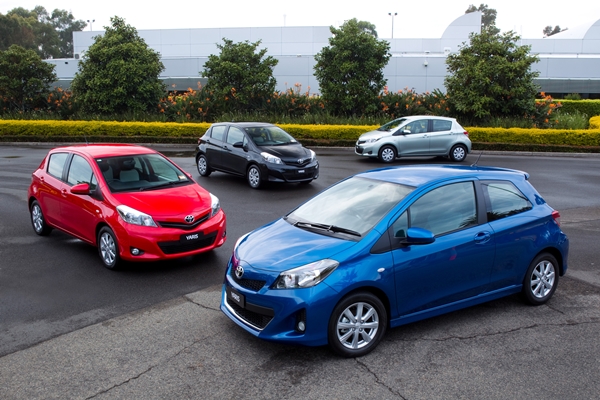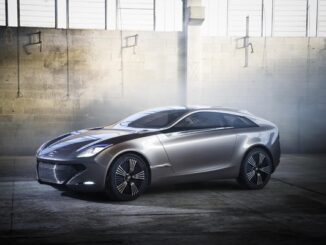a href=”https://www.ecocarguide.com.au/wp-content/uploads/2012/02/Toyota-Yaris-12-release-ext-model-range1.jpg”>
This is the third generation of the Yaris and Toyota believes it is so good that it will take sales from the opposition. That’s a bold claim. Previously the Yaris has majored in bulletproof reliability, a spacious well-built cabin, a strong range of economical engines and low running costs. Add to this sharper styling and some of the best resale in the class and it should do well. Is it good enough to be the best in class? Let’s check it out:
Behind the wheel
 < Jump inside and you’ll see that the cabin has been completely reworked. It is now much more driver-focused with the dials and instruments behind the steering-wheel. This is the first time in the Yaris’ history that the speedometer and rev counter has been placed behind the steering wheel rather than in the middle of the dashboard. The unfussy dash layout is a massive step forward and it incorporates an integrated touchscreen system at the heart of the design. The YR (base model) comes with air conditioning, power windows, power mirrors, a four-speaker sound system with CD player, USB connectivity and Bluetooth streaming. Cruise control is also optional for an additional $650.
< Jump inside and you’ll see that the cabin has been completely reworked. It is now much more driver-focused with the dials and instruments behind the steering-wheel. This is the first time in the Yaris’ history that the speedometer and rev counter has been placed behind the steering wheel rather than in the middle of the dashboard. The unfussy dash layout is a massive step forward and it incorporates an integrated touchscreen system at the heart of the design. The YR (base model) comes with air conditioning, power windows, power mirrors, a four-speaker sound system with CD player, USB connectivity and Bluetooth streaming. Cruise control is also optional for an additional $650.
Performance
The powertrains remain the most underwhelming aspect of the new car. The 63kW/121Nm 1.3-litre and 80kW/141Nm 1.5-litre are adequate in isolation, but performance is dampened by a four-speed automatic gearbox, putting Yaris at a disadvantage compared with rivals that have five gears or more in their automatic gearboxes. Above 3000rpm, both of these engines feel lively, but let them drop below 3000rpm and they are non-responsive.
Handling
The new Yaris is 20kg lighter than the previous model, with local tuning to the electric steering calibration means that the Yaris is truly impressive in the city but feels vague on the open road with little feedback for enthusiastic drivers. The handling should be helped thanks to the car being wider and longer (compared to the older model it’s 15mm wider and 100mm longer), our test route took us on motorways, twisting dirt roads and a drive up the Rob Roy Hill Climb in Victoria. Toyota claims Australian versions of the Yaris will come with local ride and handling set-up, with retuned suspension bushes and dampers, and a quicker steering rack. The steering feedback on a twisting track is impressive for a car in this market and price.
Comfort
The increase in length has freed up space for passengers, making trips more relaxing and comfortable. Compared to rivals the Yaris feels quite roomy. Two adults should fit in the rear seats quite comfortably but if you are planning longer journeys it is best to reserve the rear for teenagers or children. Comfort is good up front, but the seats could be better bolstered to improve lower back support. Road, tyre and wind noise is relatively low for a car of this size.
<img src="https://www.ecocarguide.com.au/wp-content/uploads/2011/12/Toyota-Yaris-12-release-int-boot.jpg" alt="2011 Toyota Yaris cargo space" title="2011 Toyota Yaris cargo space" width="600" height="400" class="alignnone size-full wp-image-3342" /
Practicality
The additional 100mm in length over the previous generation has helped to improve boot space. It is up 25% over the previous incarnation of the Yaris and now boasts 286 litres of luggage space – that’s two litres smaller than the Kia Rio and nine litres less than the Ford Fiesta. In such a competitive sector that could be a telling disadvantage. Fold the rear seats and the boot space expands to 768 litres. Up front there is a pair of cup holders and the door pockets are of an average size for a car in this sector.
Equipment
The entry level grade is called YR ($14,990) and comes with ISOFIX child seat fixings, and three door, five-speed manual 1.3-litre, you have the option of a four-speed automatic for an additional $1,600 and a five-door for an additional $700. Cruise control is optional on this model for $650. The base model also gets air conditioning, power windows, power mirrors, and a four-speaker sound system with CD player, USB connectivity and Bluetooth streaming. Move up to the most popular trim level the YRS, which starts from $16,890 and is comes fitted with a 1.5-litre, a five-speed manual and three doors. Five doors costs an additional $500 and a four-speed automatic gearbox can be optioned for $1,600. The YRS comes with a premium steering wheel and gear selector, a six-speaker sound system with touch screen and 15 inch steel wheels. Next up is the YRX starting at $21,390; the YRX is available in five doors only with the 1.5-litre engine and a four-speed automatic gearbox. Standard features over the YRS include 15 inch alloy wheels, fog lights, automatic headlights, automatic climate controlled air conditioning and satellite navigation with traffic management and movie playback. Need a sportier look and feel, Toyota offers the ZR, priced from $18,990 the ZR is fitted with the 1.5-litre engine, mated to a five-speed manual gearbox and is only available in three-door configuration. Features over the YRX include sports front and rear bumpers, sports grille and headlamps, rear roof spoiler with side skirts, sports front seats and exhaust pipe diffuser. In addition to adding a new variant in the Yaris line-up, Toyota has managed to retain a competitive price point and increase added value.
Safety
The previous generation of the Yaris received five stars when it was crash tested by Euro NCAP. It has a long list of safety kit as standard which should mean it retains its five star rating. Safety kit includes seven airbags as standard equipment, including a driver’s knee airbag, vehicle stability control and traction control as standard equipment. Every Yaris is also fitted with anti-skid brakes that feature the latest brake assist system and electronic brake-force distribution. Yaris also has a brake override system that prioritises braking and suppresses engine output if the brake and accelerator pedals are pressed simultaneously. As a new safety feature, Yaris has a buzzer that will sound if the vehicle starts moving while any of the doors are partly open, plus one truly innovative feature. Toyota has engineered what it claims is a world-first, wet-arm-style windscreen wiper system with washer fluid sprayed along the single wiper blade, instead of into the driver's field of vision.
Summary
The third generation of the Toyota Yaris builds on the strengths that made the first two so successful – namely durability, reliability and build quality. Unlike its predecessors, it's fun to drive and there's plenty to like about the latest Yaris and it's an easy car to recommend with cleaner engines, a more inviting interior and plenty of space too. Quality is evident throughout and Toyota has worked hard to ensure this Yaris is even better built than the last one. The result is a car that feels solid and well screwed together. On the road this shows with impressive refinement and on the motorway, the Yaris feels like a larger car with very little noise or vibration in the cabin. It comes with a revised suspension set-up and electric power steering so it's easy to drive, albeit not very involving. The ride is firm – and the handling good (more so than you'd expect from a Toyota). Yaris offers the good value and will sell up a storm, even in this competitive market. Well done Toyota.
What is good and not so good?
What is good?
Genuine good-value
Styling,
Interior Space
Features,
Chassis sets the standard for on-road balance
What’s not so good?
Low-range torque,
4 Speed Auto
Some cheap cabin fittings


